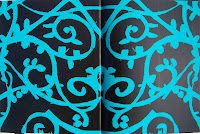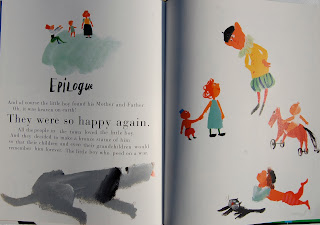The Manneken Pis is a statue in Brussels of a child urinating. Its history and origins are unclear but one of the tales told to tourists is that the statue represents a small boy who stopped a war by peeing on the enemy. Vladimir Radunsky liked this particular story so much that he created a picturebook called, Manneken Pis: a simple story of a boy who peed on a war.
The front cover shows us Radunski's version of the boy doing his deed, and the back cover is a montage of a photo of the real statue, with the words ... "The people made a bronze statue of him and named it Manneken Pis. This all happened a long time ago."Radunsky's illustrations are bold and bright, made with quick brushstrokes, done in a child-like fashion, against sparse backgrounds or sharply cut paper montages. Really nice and eye catching. The endpapers are striking, and change colour from front to back. Here are the front ones:
Radunsky is introduced to us on the back dust jacket flap ... he's dressed in the costume of the period, a little red hat and ruffles on his jacket. It's a little strange, until you recognise him later within the story and he's also on the copyright page... he's our narrator of course!
And so we begin, turn the page and we are introduced to the setting, "a small, beautiful town behind a stone wall." It looks calm and serene, the poplar trees neatly placed around the town walls, houses around a big central plaza. The sun is shining.
Throughout the picturebook Radunsky uses different sized fonts, as shown here. They cleverly focus our attention on aspects of the narrative or the illustration. The story continues by introducing the characters, a boy, and his mother and father. In a large font we read "His parents loved him madly." They kiss him and play with him, and go to the flower market with him everyday...
"They were so happy." ... in a huge big font above an exuberant page showing the family swimming in flowers. But then something happened.
"The War". A mustard yellow page, a stark contrast to the light flowery one, previous. Green faced soldiers, their tongues lolling, with dogs and medieval weapons, are seen marching across the double spread towards the idyllic town. They look mean. They ARE mean.
They fight the town's men, depicted as gentlemen, clad in tights with plumed hats and carrying swords. They are different to the club holding enemy, who seem uncouth and ignorant. The background is divided into black and white, and gives the impression of the men being either in the town or outside the walls, at the same time reinforcing the fact that they fought "Day and night, day and night."
And then our narrator appears in his red hat and frilly collar, he points to the town, "... a small, sad town." ... now sombre, against a black background, two red crosses apparent on the church-like buildings.
The little boy has lost his parents. "Where did they go?" He called but no one came. He looked and looked, but all he saw was fighting, all he heard was "Bang - Bang, Boom - Boom, Cling - Clang." Poor chap. He was scared and he needed his mum and dad ... "but he also needed ... to pee." So he did! And here we see him urinating over the fighting soldiers.
"Suddenly everything was still." Surprised faces look up, women and priests, men and soldiers. Then somebody laughed ... "ha-ha-ha-ha."
Radunsky has used that same mustard yellow, yet with all those smiling faces this yellow gives us a happy page. Even the green faced enemies are grinning, everyone is happy! And so ... "On and on it went, until the sun has set and the first star came out, and the people had grown so tired of laughing that they dropped their arms and went to sleep. When they woke up the next morning there was no more war. Why? Because of that wonderful, wonderful little boy. Hurr-a-a-ah!!!"
We are treated to an "Epilogue".
We see our little boy reunited with his family; the narrator is answering questions from his audience of child and animal listeners. And of course, now you know the story, the whole story, you "... can tell it to your children, and they will tell it to their children, and their children will tell it to their children, and so on, and so on."
The back end papers are a jovial, bright, peace-loving green ...
... and it is here that we are introduced to our narrator, on the inside flap of the dust jacket:
What a quirky little book! Could you use it in your classrooms? The message of peace is clear. Upper primary could possibly do a short project in which the students researched other statues, in their own country or other countries. Are there any that have stories of peace behind them? Are there any statues of children?
It's thanks to my friend, and fellow picturebook lover, Janet Evans, who I was chatting to about 'peace' books, that I discovered this title ... Thanks Janet!
















Hiç yorum yok:
Yorum Gönder